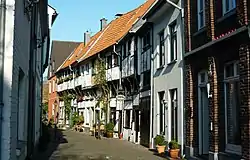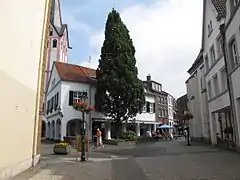Kempen | |
|---|---|
 Old School Street | |
 Coat of arms | |
Location of Kempen within Viersen district  | |
 Kempen  Kempen | |
| Coordinates: 51°21′57″N 6°25′10″E / 51.36583°N 6.41944°E | |
| Country | Germany |
| State | North Rhine-Westphalia |
| Admin. region | Düsseldorf |
| District | Viersen |
| Subdivisions | 4 |
| Government | |
| • Mayor (2020–25) | Christoph Dellmann[1] |
| Area | |
| • Total | 68.79 km2 (26.56 sq mi) |
| Highest elevation | 68 m (223 ft) |
| Lowest elevation | 30 m (100 ft) |
| Population (2021-12-31)[2] | |
| • Total | 34,562 |
| • Density | 500/km2 (1,300/sq mi) |
| Time zone | UTC+01:00 (CET) |
| • Summer (DST) | UTC+02:00 (CEST) |
| Postal codes | 47906 |
| Dialling codes | 02152 / 02845 |
| Vehicle registration | VIE / KK |
| Website | www |
Kempen (German: [ˈkɛmpm̩] ⓘ) is a town in the district of Viersen, in North Rhine-Westphalia, Germany. It is situated approximately 30 kilometres (19 mi) northwest of Düsseldorf, and 20 kilometres (12 mi) east of Venlo.
History
- 1186: First mention in official documentation of Kempen as a place – the sovereign until 1794 is the Archbishop (electoral prince) of Cologne
- around 1290: Kempen is rebuilt as a fortified town
- 11 March 1294: First confirmation of Kempen as a town in official documentation
- 15th century: town blooms economically and culturally (population of approx. 4,200)
- 1542–1543: Kempen is the centre of the Reformation for the Lower Rhine
- 1579: The plague costs the town almost half of its inhabitants
- 1642: Kempen is conquered and destroyed by the allied French, Hessian and Weimar troops during the "Hessen War" (Thirty Years' War)
- 1794–1814: Kempen is under French rule. In the département of Roer established in 1797, Kempen becomes a canton seat in 1798 and a French town in 1801.
- 1815: After the Congress of Vienna, Kempen becomes Prussian and is the county seat
- 1929: Due to local reforms, Kempen becomes the administrative seat of the county of Kempen-Krefeld
- 1966 onward: Restoration of the old town
- 1970: Communal restructuring: The communities of Hüls, St. Hubert, Tönisberg and Schmalbroich join Kempen along with the localities of St. Peter and Unterweiden to form a single town
- 1975: In further local reforms, Hüls is assigned to the city of Krefeld. The county of Viersen is formed and Kempen becomes part of "Kreis Viersen"
- 1984: The county seat is transferred from Kempen to Viersen.
- 1987: A cultural forum is opened in the Franciscan monastery after comprehensive restoration and renovation work.
- 11 March 1994: Date of the 700-year jubilee of the confirmation of Kempen as a town
Twin towns – sister cities
 Wambrechies, France (1972)
Wambrechies, France (1972) Orsay, France (1973)
Orsay, France (1973) East Cambridgeshire, England, United Kingdom (1978)
East Cambridgeshire, England, United Kingdom (1978) Werdau, Germany (1990)
Werdau, Germany (1990)
Notable people
- Thomas à Kempis (c. 1380–1471)
- John Brugman (?–1473), Franciscan friar and preacher in Flanders
- Wilhelm Hünermann (1900–1975), priest and writer
- Adolph Moses Radin (1848–1909), rabbi
- Isabel Varell (born 1961), actress and singer
- Bernhard van Treeck (born 1964), psychiatrist and author
- Tobias Koch (born 1968), pianist
- Daniel Altmaier (born 1998), Tennis player
Gallery
 View in a street
View in a street Church
Church Towngate (Das Kuhtor)
Towngate (Das Kuhtor) Lutheran church (Thomas Church)
Lutheran church (Thomas Church).jpg.webp) Hessenmühle
Hessenmühle Kempen Castle
Kempen Castle
References
- ↑ Wahlergebnisse in NRW Kommunalwahlen 2020, Land Nordrhein-Westfalen, accessed 30 June 2021.
- ↑ "Bevölkerung der Gemeinden Nordrhein-Westfalens am 31. Dezember 2021" (in German). Landesbetrieb Information und Technik NRW. Retrieved 20 June 2022.
- ↑ "Partnerstädte". kempen.de (in German). Kempen. Retrieved 28 February 2021.
External links
Wikimedia Commons has media related to Kempen (Niederrhein).
- Official website
 (in German)
(in German)
![]() This article incorporates text from a publication now in the public domain: Wood, James, ed. (1907). "Kempen". The Nuttall Encyclopædia. London and New York: Frederick Warne.
This article incorporates text from a publication now in the public domain: Wood, James, ed. (1907). "Kempen". The Nuttall Encyclopædia. London and New York: Frederick Warne.
This article is issued from Wikipedia. The text is licensed under Creative Commons - Attribution - Sharealike. Additional terms may apply for the media files.